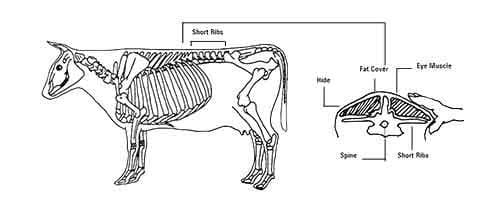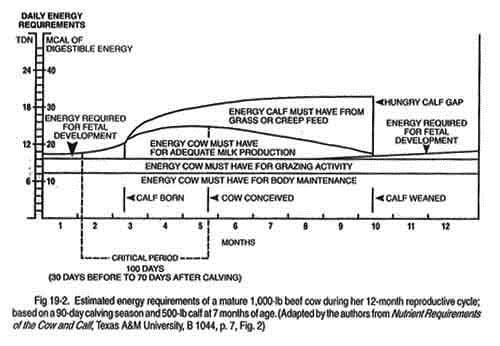Body condition scoring is a management tool designed to assess body reserves or fat accumulation of an animal. It is a great method for critically examining the nutritional status of your herd. Body condition scoring is a hands-on assessment that uses a numerical rating system based on the feel of the animal rather than descriptions based simply on a visual appraisal. In the winter, it is more effective to implement hands-on body condition scoring versus visual scoring, as winter hair coats can often hide visual cues that only hands-on scoring can assess.
Condition scores are measured by feeling for fat cover with your hands. Fat cover is measured over four major locations on the animal's body: back bone (spine or topline), short ribs, hip bones (hooks and pins) and tail head on a scale of one to five.
A five-point scale is used when scoring cattle, small ruminants, swine and elk. A score of one is assigned to an extremely skinny or emaciated animal, and a score of five is assigned to an extremely fat or obese animal. Horses are typically scored using a nine-point scale, instead.
Where To Condition Score:
Because there is no muscle between the end of the short ribs and the skin, any padding felt by the thumb will be fat. There are two main areas to check to determine condition score: the short ribs and on either side of the tail head. The tail or pin bones can also be checked to determine fat cover.

When To Condition Score:
Ideally cows should be condition scored three times in each production year as follows:
- Fall pregnancy check/start of winter feeding season = Optimum score is 3.0
- At Calving = Optimum score for Mature Cows is 3.0 & First Calf Heifers is 2.5
- Thirty days before breeding season = Optimum score is 2.5 for all females.
Animals that fall into the optimum body condition ranges have been shown to have superior fertility in terms of conception rates and day to first estrus after calving, as well as produce heavier calves, compared to animals in suboptimum body conditions. Maintaining a herd in good body condition has been proven to make producers money due to lower feeding costs and generating more income through bigger calves and better herd fertility.
The cow's changing energy requirements through the production year:

Easiest and cheapest time of year to put body condition back on to cow:
- You want to put on condition when the cow's energy requirements are at the lowest point, which is typically in the fall just after the calf has been weaned.
- Cow no longer has an energy demand from lactation and is fairly early on in gestation = Low Energy Requirements.
- Any additional energy you put into her ration either in the form of grain or good-quality forage or pasture will be converted fairly efficiently into back fat or body condition.
- The cost of gain at this point will be significantly less than it would be at any other time of year (i.e.) Near or after calving or during lactation when the cow's energy requirements are much higher will require a lot more feed to get the same results in body condition gain.
What to Remember:
- You don't need to remember all five condition scores. The most useful score to remember and to shoot for in terms of a goal is the score of 2.5 to 3.0.
- Check short ribs, tail head and pin bones for fat cover.
- At 2.5 to 3.0, you should be able to feel short ribs with some pressure, but you should not be able to count them individually. Fat cover should be evident on either side of the tail head and/or over pin bones.
- If condition has to be put back onto cows, the best time of year to do it is in the fall after the calf has been weaned.
- Sometimes when we are the ones feeding the same animals day after day we overlook or miss slight body condition changes that happen over time. For this reason, body condition scoring is a great reason to take some time to take a close, critical look at your herd. It might even end up being a good excuse to call up a neighbour for a coffee and a drive through the country, as a fresh set of eyes looking at your animals is never a bad idea, especially during the winter.
- For more information on body conditioning on other livestock, refer to the Body Condition Scoring Handbook (linked below in the Related Items).
